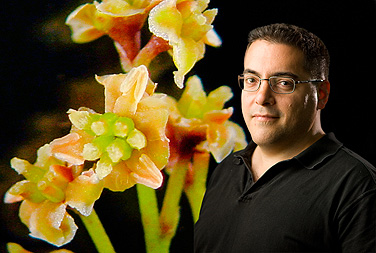News
Where did flowers come from?

UB biologist Victor Albert, shown here with an amborella, is part of a team that is sequencing the genome of that flower in order to study the origins of all flowers. Photo: DOUGLAS LEVERE
-
 Print
Print -
 Comments
Comments
-
Multimedia

Victor Albert is working on a multi-institution project exploring the origins of flowers. Watch an interview.
UB is a key partner in a $7.3 million, multi-institution collaboration to explore the origins of all flowers by sequencing the genome of Amborella, a unique species that one researcher has nicknamed the “platypus of flowering plants.”
Amborella is an understory shrub or small tree found in only one place on the planet: the Pacific islands of New Caledonia. The plant, a direct descendant of the common ancestor of all flowering plants, is the single known living species on the earliest branch of the genetic tree of life of flowering plants.
As such, Amborella is a molecular living fossil, says Victor Albert, UB Empire Innovation Professor in biological sciences and a co-principal investigator on the Amborella genome project.
In the same way that the DNA of the platypus, a mammal of ancient lineage, can help us study the evolution of all mammals, the DNA of Amborella can help us learn about the evolution of all flowers, Albert says.
Specifically, by comparing the genetic make-up of Amborella to that of newer species, biologists will be able to study a diverse range of plant characteristics—from how flowers resist drought and how fruits mature to how critical crops might respond to global warming.
“This is work that’s related to the human condition in various ways. We’re talking about food, fiber, fuel and the future,” says Albert, a faculty member in UB’s New York State Center of Excellence in Bioinformatics and Life Sciences. “Most of our food comes from flowers. All the fruit crops and grains are flowering plants. Cotton fiber is from fruit, and fruits come from flowers. Soybeans are fruits. Rice comes from the seed of a flowering plant.”
Albert’s co-investigators include Claude W. dePamphilis at Pennsylvania State University, who is leading the research; Hong Ma and Stephan Schuster at Penn State; Douglas E. Soltis, Pamela S. Soltis and W. Brad Barbazuk at the University of Florida; Steven D. Rounsley at the University of Arizona; James Leebens-Mack at the University of Georgia; Jeffrey Palmer at Indiana University; and Susan Wessler at the University of California-Riverside. The National Science Foundation is funding the project.
The team plans to complete and publish a draft sequence of the Amborella genome this year, Albert says. To share results with scientists around the world, the group will make the genome available online.
“The Amborella genome and the strategies we are using to obtain and analyze the genome will provide not only a unique scientific resource with broad impacts on plant biology, but it also will provide excellent opportunities to demonstrate the utility of an evolutionary perspective across the biological sciences,” says Albert, who is also a member of teams sequencing the genomes of coffee and avocado.
The Amborella project builds on another floral genetics project that dePamphilis of Penn State led. In that earlier study, he and partners, including Albert, sought information on the origins of flowers by comparing active genes of flowering plants, among them Amborella, and non-flowering plants called gymnosperms.
The team published major findings in the Proceedings of the National Academy of Sciences in December, reporting that genetic programming found in gymnosperm cones gave rise to flowering plants.
The Amborella genome project is the natural next step: Now that we know more about how the first flowers evolved, what can we learn about how they diversified? With a fossil record dating to a little more than 130 million years ago, flowering plants now include as many as 400,000 species on land and in water.
Sequencing a genome involves determining the order in which nucleotide bases—adenine, guanine, cytosine and thymine—appear in strands of DNA.
To complete this task, the Amborella team is employing “shotgun” technology that breaks DNA into tiny bits, sequences those bits simultaneously and reassembles them into a long chain. The approach is cheaper and quicker than older methods that require scientists to sequence entire strands of DNA in order, beginning at one end and moving to the other.
At UB, Albert and fellow researchers will use visual mapping to check their colleagues’ work, examining large pieces of sequenced DNA under a microscope to make sure those pieces fit correctly on Amborella chromosomes. (Though scientists do not know the exact sequence of the Amborella genome, they do already know how large chunks of DNA map to one another.)
UB researchers also will compare Amborella’s genetic material to that of other plants, including rice, the cucumber, the tomato and the potato.
The goal of these comparative studies is to learn more about whole-genome duplication, a commonplace process in flowers in which a new plant inherits an extra, duplicate copy of its parents’ DNA. Because redundant copies of genes can evolve to develop new functions, scientists think that whole-genome duplication may be behind “Darwin’s abominable mystery”—the abrupt proliferation of new varieties of flowering plants in fossil records dating to the Cretaceous period.
Amborella has relatively few chromosomes, leading biologists, including Albert, to conclude that the species may never have undergone such a doubling.
Besides research, the Amborella genome project also includes plans for creating education, training and mentoring opportunities for high school students, undergraduates, graduate students and postdoctoral researchers.

Reader Comments